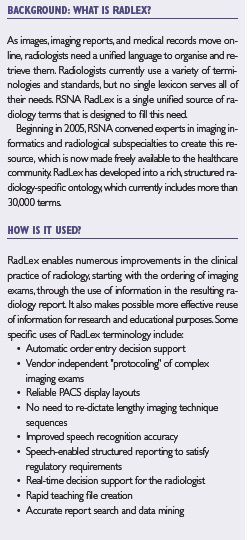HealthManagement, Volume 12 - Issue 1, 2012
The Radiological Society of North America (RSNA) released the first version of the RadLex Playbook (http://playbook.rsna.org) on November 1 during the recently past RSNA congress, and already this resource has found eager users in the radiologic community. The Playbook provides a standard, uniformly structured set of names for radiology procedures. The RadLex Playbook was demonstrated in the Image Sharing Demonstration booth at the RSNA 97th Scientific Assembly and Annual Meeting at McCormick Place in Chicago.
The initial release of the Playbook provided names for more than 350 common CT procedures. It was developed by extracting names from “chargemasters” - lists of orderable procedures - from several large radiology sites and adapting them to the standardised structure defined for Playbook terms.
The Playbook fills a significant gap in the web of information used in radiology: the absence of a consistent way of referring to specific radiology procedures. Currently each institution develops its own list of procedure names. Considerable effort is expended in creating and maintaining these lists. Moreover, the fact that each site develops and maintains its own list thwarts the ability of each institution to use its information for secondary purposes like clinical trials, outcomes analysis, national registries, and other quality improvement efforts. This coming year the RadLex Playbook project will release a set of terms for standardised naming of MRI and x-ray procedures.
“The release of the RadLex Playbook is an important milestone for radiology, as it brings us into the era of large-scale efforts to understand and improve our imaging practices, and to enhance our access to and use of imaging information in clinical practice, teaching and research,” said Daniel L. Rubin, M.D., M.S., assistant professor of radiology and medicine at Stanford University and Chair of the RadLex Steering Committee of the RSNA.
The Playbook provides the crucial technology to enable all institutions and practices to improve the quality of data shared with image and dose registries.
American College of Radiology an Early Adopter
The American College of Radiology (ACR) has become an early adopter of the Playbook for use in its CT Dose Index Registry (DIR; https://nrdr.acr.org/Portal/DIR/Main/page.aspx). The DIR allows facilities to compare their CT dose indices to regional and national values. Using Playbook procedure names makes it possible to effectively analyse and compare the information submitted to establish national benchmarks. The ACR has begun applying Playbook procedure names to the data it collects and using them in the reports generated through the DIR.
“We have found that procedure names vary between and even within imaging facilities,” said Richard Morin, Ph.D., FACR, and Chair of the Dose Index Registry Committee. “Use of the RadLex Playbook allows the Dose Index Registry to standardise exam names across hundreds of facilities which, in turn, allows us to make more accurate comparisons in our feedback reports. We consider this to be essential, and it distinguishes the ACR DIR."
Playbook names also provide substantial benefits in clinical applications. They enable more accurate ordering and scheduling, standardised image acquisition protocols, automated selection of reporting templates and more efficient and accurate coding and billing.
RadLex is being adopted by users and developers of imaging- related HIT systems and other applications that can benefit from radiology-specific coded terminology. Some early applications include radiology decision support and reporting tools and search applications for radiology research and education. Reporting templates developed by the RSNA Reporting Committee use RadLex terms in their content. Reports using RadLex terms are clearer and more consistent, removing potential for error and confusion. Clinical trials investigators can use RadLex terms to "tag", index, search and analyse radiology-related medical data. Developers of educational tools can likewise use RadLex to organise their materials and make their contents more definitive.
The RadLex project is led by a steering committee of experts in radiology informatics and medical terminologies and overseen by the RSNA Radiology Informatics Committee. In 2005, six RadLex organ system committees were formed in collaboration with more than 30 radiology professional and standards organizations, including ACR, DICOM, and IHE. In 2007, six additional committees were recruited, each focusing on a specific imaging modality. These modality committees have defined terms to describe the devices, imaging exams, and procedure steps performed in radiology, an effort called the RadLex Playbook. These committees support the steering committee in ongoing development and curation of RadLex.
RadLex is freely available for download and use in clinical, research and educational applications. Radiologists and developers of radiology reporting systems can incorporate RadLex terms into their diagnostic reports by adopting the RSNA reporting templates available here. Experts in radiology and medical informatics are invited to participate in the development and curation of RadLex.





